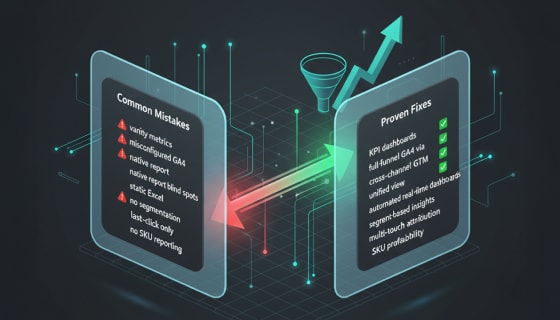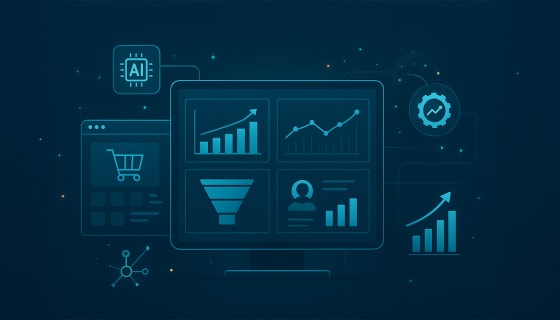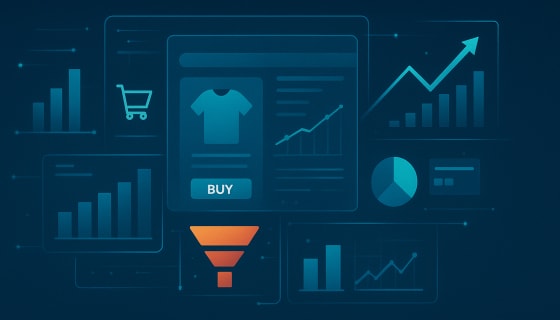Every growth-focused business quickly discovers that siloed CRM systems, fragmented ERP data, and disconnected eCommerce solutions create costly blind spots. Without real-time data integration across these platforms, decision-makers lack the unified view required to capitalize on opportunities, optimize operations, and deliver seamless customer experiences. Prospects vanish, resources are misused, and competitors gain an advantage. Worse still, your team wastes time piecing together reports from multiple sources while actionable insights slip through the cracks.
Sound familiar? For businesses poised to scale, acting before outdated data flows derail growth is crucial. CRM and ERP integration isn’t just a technical enhancement—it’s a strategic move toward unified data that enables sharper decisions, faster execution, and greater confidence. Integrated systems do more than streamline operations—they personalize customer interactions, minimize errors, and lay the foundation for sustainable, scalable growth.
Now’s the moment for a more innovative approach: unified eCommerce, CRM, and ERP platforms enable you to automate workflows, lift customer satisfaction, and convert more sales—all from a single source of truth. Savvy leaders recognize that integrated data management is the foundation of unbeatable agility in today’s rapidly evolving digital market. Seize the edge, eliminate manual bottlenecks, and propel your brand ahead with purposeful integration.
What is Data Integration?
Data integration refers to the process of combining data from multiple sources, including CRM systems, ERP platforms, and eCommerce databases, into a unified dashboard or system. This integration enables businesses to gain a comprehensive view of their operations, customers, and performance in real-time, helping streamline processes and drive informed decision-making. According to a Domo report, companies that make data-driven decisions are 5 times more likely to make quicker decisions than their competitors. Furthermore, data integration leads to more efficient business workflows and can significantly reduce manual data entry, errors, and delays.
Understanding CRM, ERP, and eCommerce Systems
When discussing CRM (Customer Relationship Management), ERP (Enterprise Resource Planning), and e-commerce systems, we’re examining three foundational tools that help businesses streamline their processes.
CRM systems, such as Salesforce, HubSpot, and Zoho, focus on tracking interactions and data related to customers. They offer valuable insights into customer behavior, preferences, and history, enabling sales teams to foster stronger relationships and boost conversions.
ERP systems, such as SAP, Oracle, or Microsoft Dynamics, manage internal processes like inventory, human resources, finance, and supply chain management. These systems enable organizations to standardize operations, eliminate redundancies, and enhance overall efficiency.
Ultimately, e-commerce platforms, including Shopify, WooCommerce, and Magento, provide businesses with the tools to manage their online stores, track customer purchases, and process payments.
By integrating these three systems into a unified platform, businesses can eliminate the silos that often create inefficiencies. Data from customers, inventory, and financials all flow seamlessly, offering a 360-degree view of business performance. This ensures that key decision-makers have access to accurate, real-time data, leading to improved strategies and outcomes.
The Role of Data Integration in Business Operations
By combining data from CRM, ERP, and eCommerce systems, businesses break down silos, allowing all departments—from sales and marketing to finance and customer service—to work with the same up-to-date information.
Imagine a business that operates multiple departments, but with each one functioning in isolation. The sales team sees one version of the customer, the finance department another, and the supply chain team yet another. This leads to miscommunication, errors, and inefficiency. Data integration eliminates these challenges by providing a single source of truth. All departments access and use the same data, ensuring consistency and better alignment across the organization.
Efficiency is another significant benefit of data integration. Businesses can automate routine tasks, such as reporting and invoicing, allowing teams to focus on strategic activities that drive growth. For example, automated reports can be generated based on integrated data, saving hours of manual work while also increasing accuracy.
Furthermore, integration also enhances decision-making. Leaders can access real-time analytics and dashboards that offer comprehensive insights into sales, customer behavior, inventory levels, and financial performance. This agility in decision-making is crucial, particularly in fast-moving industries where being proactive is key to staying ahead of competitors.
By integrating CRM, ERP, and eCommerce data, businesses not only save time and money but also gain a deeper understanding of their customers and operations, allowing them to make better, more informed decisions that ultimately lead to growth.
How to Integrate CRM, ERP, and eCommerce Systems into One Dashboard
Integrating CRM, ERP, and eCommerce data into a single, unified dashboard can be a game-changer for your business. Imagine eliminating the hassle of switching between multiple systems and platforms just to get a comprehensive view of your operations. By integrating these systems, you can centralize your business insights, streamline workflows, and improve decision-making across departments. Here’s how to get started with this process and the best tools to use along the way.
Step-by-Step Guide to CRM, ERP, and eCommerce Data Integration
Integrating your CRM, ERP, and eCommerce systems might seem overwhelming, but it doesn’t have to be. Follow these simple steps to ensure seamless integration:
- Assess Your Current Systems
Start by evaluating the CRM, ERP, and eCommerce systems you are currently using. Identify the data each system holds and pinpoint potential opportunities for integration. This step will help you understand what information you need to sync and any challenges you might face. - Choose the Right Integration Method
There are several ways to integrate your systems:
-
- Pre-built integrations: Many platforms, like Shopify and Salesforce, offer pre-built integrations with ERP and CRM solutions.
- Custom API integrations: For more flexibility, you can use APIs to connect your systems. This is especially useful if you have specific requirements or use less common software.
- Integration platforms: Tools like Zapier or MuleSoft allow you to create integrations without needing to write complex code.
- Select Your Integration Tools
Once you’ve identified the integration needs, choose the right tools. API connectors, middleware platforms, or third-party integration tools, such as Zapier and Integromat, can help automate the flow of data between systems. - Automate Data Flow
Automating data flow is key to making your integration effective. Set up automated processes to ensure data is updated in real-time. This eliminates the need for manual data entry and ensures consistency across your CRM, ERP, and eCommerce platforms. - Test and Monitor the Integration
Before going live, test the integration thoroughly to ensure all systems are syncing as expected. Once live, continuously monitor the integration for issues such as data discrepancies or broken connections. - Train Your Team
Finally, ensure your team is adequately trained on the new integrated system. They should understand how to use the dashboard, interpret the data, and maintain the integration.
By following these steps, you’ll have an integrated dashboard that delivers accurate, real-time insights into all aspects of your business.
Choosing the Right Integration Tools: What to Look For
Selecting the proper integration tools is crucial for the success of consolidating your CRM, ERP, and eCommerce systems. Best data integration tools enable you to seamlessly combine information from various sources into a single, unified dashboard. But how do you choose the right tools for your specific needs? Here’s what to look for:
Key Features of an Effective Data Integration Tool
| Data Integration Tool | Key Features | Best For | Integration Strengths |
| Zapier | Automated workflows, easy-to-use interface, vast app connections | Small to Medium Businesses | Easy integration for CRM (Salesforce, HubSpot), ERP (QuickBooks), and eCommerce (Shopify, WooCommerce) with no coding required. |
| MuleSoft | Data mapping & transformation, API management, scalable | Large Enterprises, businesses with complex needs | Deep integration capabilities across CRM, ERP, and eCommerce systems, ideal for large organizations with complex workflows |
| Fivetran | Automated data syncing, real-time data integration, reliable data pipelines | Data-driven businesses, analytics-focused enterprises | Ensures real-time data sync across CRM (Salesforce), ERP (SAP), and eCommerce (Shopify) with minimal manual intervention. |
| Dell Boomi | Cloud-based integration, real-time syncing, data mapping | Enterprises, large global businesses | Provides a cloud-based solution for complex CRM, ERP, and eCommerce integrations at scale. |
| Workato | Custom triggers, automated workflows, real-time syncing | Large businesses, enterprise solutions | Highly customizable with deep integrations for CRM (Salesforce), ERP (Oracle), and eCommerce (WooCommerce). |
Challenges in Data Integration and How to Overcome Them
Data integration is the process of combining data from multiple sources to provide a unified view of the information. While essential for analytics and decision-making, it presents several technical and organizational challenges that can impact accuracy, speed, and security.
- Multiple Data Sources and Formats
Integrating data from diverse systems such as databases, APIs, and SaaS platforms often requires complex data transformation due to varying data schemas and formats.
✔️ 67% of businesses cite integration across diverse data formats as a significant concern. - Data Silos
Different departments or tools often operate in isolation, making centralized access to and analysis of data difficult. This fragmentation hampers business intelligence and increases redundancy.
✔️ 80% of enterprises identify data silos as a key blocker to high-quality, integrated data operations. - Schema and Source Changes
Changes in the structure or design of source data (e.g., modified columns or renamed fields) can disrupt data pipelines and necessitate ongoing maintenance.
✔️ Nearly 40% of organizations report frequent integration breakdowns due to unexpected schema changes. - Poor Data Quality
Duplicates, missing values, or inconsistent formatting significantly reduce the reliability of integrated datasets and models. Data cleansing is often time-consuming but critical.
✔️ Poor data quality costs U.S. businesses an estimated $3.1 trillion annually. - Delays and Data Latency
Efficient integration requires timely data ingestion; however, many systems face lags due to batch processing or network issues, resulting in outdated insights.
✔️44% of businesses identify data latency as a primary barrier to real-time analytics. - Data Security and Privacy Risks
Merging datasets increases exposure to cyber threats and compliance violations. Insecure APIs, unauthorized access, and regulations such as GDPR further complicate integration.
✔️ 55% of respondents say their data security strategy isn’t keeping pace with evolving risks—including those related to integration and AI—underscoring that security is a leading challenge in integrated data environments. - Lack of Common Data Understanding
When teams interpret the same data differently, the resulting inconsistencies hinder unified reporting and KPI tracking. Standardizing definitions is key.
✔️ 37% of integration inefficiencies can be attributed to poor alignment on data definitions across departments. - High Data Volume and Complexity
Handling massive volumes of structured and unstructured data from numerous channels requires powerful tools and scalable storage solutions.
✔️Global data creation is expected to reach 394 zettabytes by 2028. - Resource and Skill Constraints
Successful data integration requires specialized skillsets in data engineering, security, and governance—roles that many organizations struggle to source or hire for.
✔️ 85% of organizations report moderate to extreme skill shortages in data and digital roles, making talent scarcity one of the most significant barriers to successful integration projects.
Automation in Data Integration: Streamlining Business Processes
If you’re tired of manually transferring customer, sales, and inventory data across systems, automation can unlock real-time, accurate data to boost efficiency. Start by identifying the key data points you need to sync between your CRM, ERP, and eCommerce systems (like customer info, inventory, and orders). Choose an automation tool like Zapier, MuleSoft, or Workato to create workflows that update systems automatically—such as syncing CRM data and adjusting ERP inventory when an order is placed. Set up triggers, such as “When an order is placed, update the CRM and ERP,” to automate the process. Finally, monitor the automated workflows with tools like Integromat to ensure real-time syncing and prevent disruptions.
How to Automate Data Flow Between CRM, ERP, and eCommerce Systems
- Identify Your Key Data Points:
- What information needs to be synced across CRM, ERP, and eCommerce?
- Examples: Customer info (CRM), inventory and finance (ERP), orders and product data (eCommerce).
- Mapping these data points helps identify essential data for automation.
- Choose the Right Automation Tool:
- Tools like Zapier, MuleSoft, or Workato can integrate your systems without needing coding.
- These tools enable you to create automated workflows, such as automatically updating a CRM with customer details and adjusting inventory in an ERP when a customer places an order.
- Set Your Triggers:
- Define the conditions under which data should be transferred from one system to another.
- Example trigger: “When an order is placed on the website, update the ERP and CRM with customer details and inventory data.”
- Automation tools enable you to set custom triggers tailored to your specific business needs.
- Monitor Your Automated Workflows:
- Use platforms like Integromat to monitor data flows, ensuring no disruptions.
- Regular monitoring helps optimize workflows and resolve issues, keeping your data accurate and up-to-date.
Real-Time Data Syncing for Improved Decision-Making
The value of real-time data syncing cannot be overstated when it comes to CRM, ERP, and eCommerce integration. Imagine having access to customer, inventory, and sales data all in one place, instantly updated as changes occur. Real-time data syncing enables your business to respond to trends, customer demands, and market changes in real-time—without waiting for the end of the day or week.
When data is updated across all systems in real-time, decision-makers can act quickly. For example, a customer might update their contact information in the CRM, and that data is immediately reflected across your ERP and eCommerce systems. If stock levels change, the ERP can update the CRM, ensuring that sales and customer service teams are aware of precisely what’s available. This ensures data consistency, enabling your team to work with the most accurate and up-to-date information possible.
Additionally, real-time syncing improves customer service. When customer service teams have immediate access to order statuses, inventory levels, and past purchase information, they can provide faster and more accurate support. Not only does this improve customer satisfaction, but it also boosts customer loyalty.
In an increasingly data-driven world, real-time syncing isn’t just a convenience—it’s a critical advantage that empowers businesses to make informed decisions more quickly and efficiently than ever before.
Data Security and Compliance: Protecting Your Integrated Data
As your business connects various systems and platforms, the security of your integrated data becomes a top priority. With sensitive information flowing seamlessly across different systems, ensuring robust protection is crucial.
This section guides you through the necessary steps to secure your data and maintain compliance with regulations such as the GDPR and HIPAA. You’ll learn best practices for safeguarding your data from breaches, as well as strategies to keep your business compliant. By understanding the importance of data encryption, access controls, and continuous monitoring, you’ll be equipped to protect both your data and your customers, while setting your business up for secure, scalable growth.
Best Practices for Securing Your Data During Integration
When integrating multiple systems, ensuring the security of your data is critical. Here are best practices to help you protect your information:
- Use Encryption: Always encrypt sensitive data both in transit and at rest to prevent unauthorized access.
- Implement Access Controls: Restrict data access to authorized users only, using role-based permissions and multi-factor authentication (MFA).
- Regular Audits: Conduct regular security audits and vulnerability assessments to identify potential risks and ensure compliance.
- Secure APIs: Utilize secure API connections and authentication methods, such as OAuth, to protect the data exchanged between systems.
- Monitor Data Flows: Continuously monitor your integration processes for unusual activity or breaches to ensure data integrity and security.
- Compliance with Regulations: Ensure that all integrated systems meet industry standards, such as GDPR, HIPAA, or CCPA, to avoid legal repercussions.
- Backup Data: Regularly back up your integrated data to protect against data loss or corruption that may occur during integration processes.
Case Studies: Real-World Examples of Successful Data Integration
Real-world examples demonstrate how leading companies have leveraged data integration to streamline their operations, enhance decision-making, and increase customer engagement. By consolidating CRM, ERP, and eCommerce systems, these organizations have unlocked new efficiencies and achieved measurable business growth. The following case studies highlight these successes and the tangible benefits of strategic data integration.
First, Coca-Cola Enterprises (CCE) successfully integrated sales, customer orders, transactions, and inventory data from scattered sources into a centralized platform. This unified view empowered sales teams with accurate analytics and trend identification, resulting in a notable 7% increase in sales and improved sales forecast accuracy.
Building on the theme of system consolidation, a leading global eCommerce retailer successfully unified customer data scattered across CRM, ERP, and e-commerce platforms. This integration enabled a holistic view of customers, allowing the company to streamline marketing outreach and personalize experiences across web, mobile, and physical stores. The initiative resulted in a remarkable 35% increase in personalized marketing effectiveness and a 22% uplift in customer retention, illustrating the measurable benefits of harmonizing core business systems to improve customer engagement and drive revenue growth.
ROI of Data Integration: How It Impacts Your Business
Data integration directly impacts your business’s bottom line by improving efficiency, reducing costs, and enabling better decision-making. By centralizing data from various platforms, businesses can automate workflows, improve data accuracy, and streamline operations.
In this section, we’ll explore how integrating your systems leads to cost savings and enhanced efficiency, as well as how to measure the return on investment (ROI) from these efforts. You’ll learn how automating data flows can make your business more agile, efficient, and responsive to change.
How Data Integration Leads to Cost Savings and Improved Efficiency
Manual processes are prone to errors, time delays, and inefficiencies. By implementing data integration, businesses can automate routine tasks such as data entry, inventory tracking, and order management, leading to significant cost savings. For example, when CRM, ERP, and eCommerce systems are integrated, data flows automatically between platforms, reducing the need for manual updates and ensuring consistency across departments. This streamlining of processes boosts productivity and reduces labor costs, as employees can focus on more strategic tasks instead of administrative work.
Moreover, integration helps eliminate data silos. Having a unified view of business operations leads to better decision-making. Teams can quickly access real-time information, making processes such as inventory management, order fulfillment, and customer service more efficient. This level of automation and data centralization leads to increased business efficiency, enabling your organization to respond more quickly to changes and enhance overall operations.
Measuring the Success of Your Data Integration Strategy
To assess the ROI of your data integration strategy, it’s essential to track specific metrics that reflect both cost savings and operational improvements. Start by monitoring:
- Cost Reduction: Calculate the savings from automating data entry, report generation, and inventory updates, reducing the need for manual labor.
- Productivity Gains: Track how much time employees save with real-time data and automated workflows, allowing them to focus on higher-value tasks.
- Error Reduction: Measure the reduction in errors that come from manual data handling. Fewer errors lead to fewer corrections and a smoother workflow.
- Customer Satisfaction: Monitor improvements in customer service response times, product availability, and personalized experiences due to integrated data.
- Scalability: Evaluate how your integration solution scales with your business. If it enables growth without increasing overhead, it’s an apparent success.
By focusing on these key performance indicators (KPIs), you can effectively measure the success of your data integration efforts and quantify the value it brings to your business.
The Future of Data Integration: Trends and Emerging Technologies
As data integration continues to evolve, new trends and technologies are reshaping how businesses connect, manage, and analyze their data. From AI and machine learning to cloud-based solutions, these advancements are not only improving the speed and efficiency of integration but also unlocking new opportunities for businesses to optimize their operations.
In this section, we’ll dive into the emerging technologies that are transforming data integration, highlighting how AI, machine learning, and cloud solutions are paving the way for the future of integrated systems. You’ll learn how these innovations can drive intelligent automation, improve data accuracy, and enable businesses to scale seamlessly.
Trends and Emerging Technologies in Data Integration
Here are key trends and emerging technologies shaping the future of data integration:
- AI and Machine Learning for Intelligent Automation
- AI-powered data mapping and machine learning algorithms can automatically identify patterns, improve data quality, and enhance decision-making.
- Predictive analytics models enable businesses to forecast trends and optimize operations by leveraging real-time, integrated data.
- Cloud-Based Integration Platforms
- Cloud solutions like AWS, Google Cloud, and Microsoft Azure are enabling businesses to scale their integration efforts without the limitations of on-premise infrastructure.
- Cloud-based integration tools enable the real-time synchronization of data between systems, offering flexibility and scalability, particularly for growing businesses.
- Serverless Data Integration
- Serverless computing offers greater efficiency, flexibility, and cost savings in data integration by allowing businesses to run integration tasks without managing servers or infrastructure.
- This trend is making data integration more accessible and scalable, particularly for businesses with dynamic, fluctuating data demands.
- API Integration and Microservices Architecture
- APIs and microservices enable businesses to create modular, flexible integration solutions that are easy to maintain and scale.
- APIs allow seamless communication between CRM, ERP, and eCommerce platforms, while microservices enable faster development and more efficient data flows.
- Blockchain for Secure Data Integration
- Blockchain technology is emerging as a solution for securing data transactions during integration, providing transparency and immutability to ensure data integrity across systems.
- Blockchain is beneficial for industries that require high levels of security and data traceability, such as finance and healthcare.
- Data Virtualization for Real-Time Access
- Data virtualization enables businesses to access and query data from various sources without physically moving the data, thereby streamlining the integration process.
- This technology provides real-time access to integrated data, enabling more agile decision-making without compromising performance.
- Low-Code and No-Code Integration Platforms
- Low-code and no-code platforms, such as Zapier and Workato, are simplifying data integration, enabling businesses with minimal technical expertise to set up and manage integrations.
- Their platforms are driving automation and self-service integration, reducing reliance on developers.
- Edge Computing for Decentralized Data Processing
- Edge computing processes data closer to the source, enabling faster and more efficient integration of data from remote or IoT devices.
- This trend is becoming particularly relevant as the amount of data generated by IoT devices continues to rise, requiring more localized data processing.
- Robotic Process Automation (RPA) for Data Integration
- RPA tools automate repetitive tasks, such as data entry and data extraction, thereby reducing manual effort and improving accuracy.
- RPA is increasingly being used to integrate data from legacy systems with modern cloud-based platforms, bridging the gap between outdated and new technology.
- Data Governance and Compliance Automation
- As businesses handle more integrated data, automated data governance and compliance tools are emerging to ensure data integrity, security, and adherence to regulations (e.g., GDPR).
- These tools help businesses automate compliance monitoring, reducing the risk of violations and penalties.
Conclusion
Bringing together CRM, ERP, and eCommerce data into a unified dashboard isn’t just about efficiency—it’s about empowering your entire business with clarity, speed, and more intelligent decision-making. With real-time insights, automated workflows, and secure data syncing, organizations can eliminate blind spots and focus on what matters most: growth. As integration technology continues to evolve, staying ahead means choosing tools and strategies that scale with your ambitions.
If you’re considering this transformation, exploring expert-led implementation can accelerate success. Partners like ZealousWeb bring experience in custom integrations, scalable solutions, and secure data frameworks—supporting your business at every step of its data journey.













